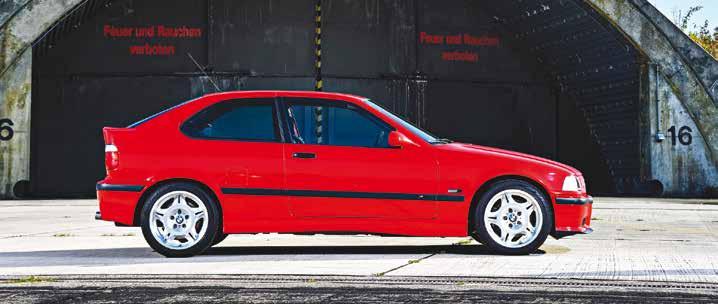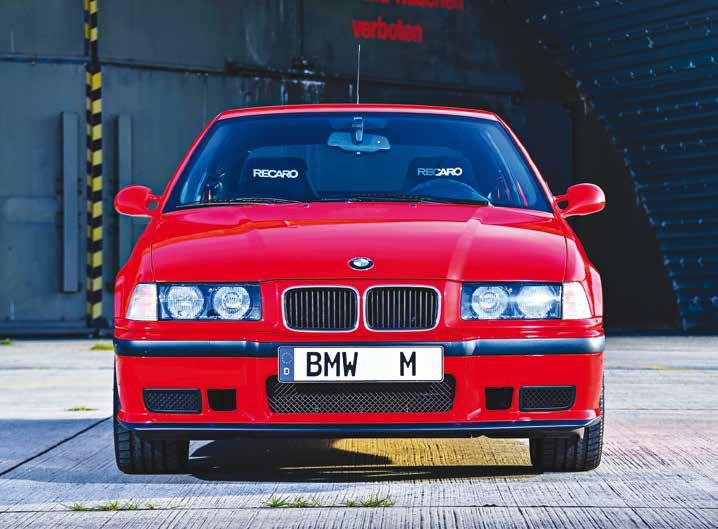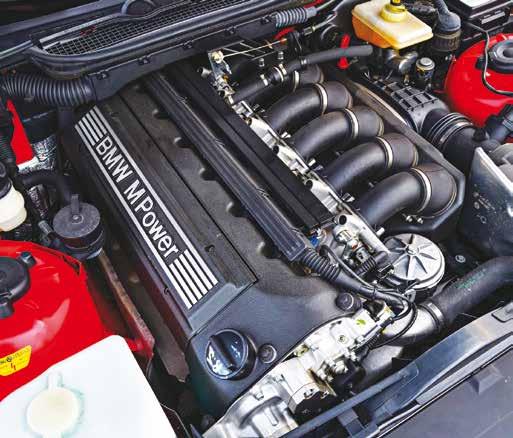
14 minute read
Red-Hot Hatch
Tech fans and car lovers know M3 Evo Coupé provided a hefty 321bhp M wanted the M3 Compact to inspire that if you give engineers free when roused with the right foot. If the car a younger customer base in particular. reign every now and then, had ever gone into series production, With that in mind, considerations extraordinarily exciting things however, engineers would probably have like comfort and space were pushed can come as a result – take BMW’s Z1 had to dial down its power in order to down the pecking order and fun factor and Z3 M Coupe for instance. Limits improve drivability. Due to the compact were brought to the fore. Achieving are pushed and surpassed, standards dimensions and low weight, it quickly maximum sporty appearance and are redefined. As an exercise in pushing became clear during test drives that the uncompromisingly agile handling was the the boundaries of what was technically M3 Compact was an innovation best left main aim of the day. possible, 1996’s BMW M3 E36 Compact in the hands of experienced drivers only. It’s with good reason that many is impressive proof of this. While some It also would have been very difficult to fans regard this high-performance say it was too far ahead of its time (and market - how could you sell a car that is car as a pioneer and the forerunner others may argue it was perhaps a lighter, quicker, more alive, and of course, of iconic models such as the 1 Series little too lively!), the car still provided an cheaper, than the hero car it borrowed its M Coupé, M2, M140i and M135i. exciting glimpse into the future. drivetrain from? Not least because with the M3
The heart and soul of the M3 Compact With its extraordinarily drivable overall Compact’s significantly shorter body, is of course, its engine. The inline 6-cylinder package and the progressive, almost BMW M engineers achieved tangible engine (S50B32) borrowed from the iconic rebellious design of the prototype, BMW improvements: the prototype weighs RED-HOT HATCH! 150kgs less than the E36 M3 Evo Coupé. In addition to its light weight of 1,300kgs, one of the M3 Compact’s trump cards is that reduced length. The rear overhang of the prototype is a good 230mm shorter than the Coupé, making it more agile thanks to less active mass behind the axle. However, while it is often reported that the wheelbase is also shorter than
Advertisement
The BMW E36 M3 Compact never went into series production, and yet its impact is still felt today. Long before small hatchbacks with over 200hp became a favourite with the yoof and petrolheads alike, it already offered everything that makes this class of vehicle so popular. So it’s no surprise that many view it as the pioneer of the successful models that followed, such as the BMW’s 1 Series M Coupé, M2 and the M140i/M135i.
Words BMW-M.com / Jeff Heywood – Photos BMW Press
The only angle where visually the M3 Compact differs from the Coupe, the Compact’s hatchback bustle making it quite distinctive, if not overly pretty

that of the regular E36 3 Series, it is in fact identical.
Numerous other measures were taken to further reduce the M3 Compact’s weight, which is particularly evident in its minimalist interior. In order to achieve a power-to-weight ratio that is impressive even by today’s standards, everything not absolutely necessary was stripped away. In return, the prototype received a genuine roll bar and racing seats from Recaro. Remnants from the E30 3 Series are also striking, such as the driver-oriented centre console and the air vents in the dashboard. This is where the Compact clearly differs from its series-produced siblings.
So what was the M3 Compact like to drive? We have to consult our friends at Germany’s famous fortnightly, Auto Motor und Sport, who’s (then) well known journalist Max Huber was given the opportunity in 1996 to test drive the M3 Compact – he was the only person outside of BMW to ever drive the M3 Compact in anger.
“Turning the key in the M3 Compact’s ignition unleashes a different animal immediately than the M3 Evo Coupe from which this car derived. The bark of the exhaust is deeper, louder, more guttural (a BMW M engineer assured me that the exhaust fitted to the prototype was a ‘pre-production item’ and a quieter system would be fitted to a production version, to which I winced!) You see, I liked that the M3 Compact felt more alive, more animalistic, because I had openly criticised BMW after driving the first (non-Evo) E36 M3 when it arrived 4 years ago (in 1992). It was too tame, too refined, too… GT-like. It obviously had massive shoes to fill following on from the E30 M3, especially the Sport Evo model, but I just felt that the new E36 M3 felt a touch anodyne. BMW answered the criticisms (partly) with the Evo version of the E36 M3 (which donates its engine and gearbox and one or two other parts to this project) upping power by nearly 40 horsepower and sharpening the car up slightly, although it still wasn’t perfect; in my eyes it still felt like a very quick GT.
“BMW’s marketing people didn’t like the fact that I had criticised their new M3 back then so I was surprised I was invited back to the BMW M facility at Garching to drive the M3 Compact! And yes, this car feels raw. Gone is the GT smoothness of the Coupe and in its place is a firebreathing monster. But that could be a mental impression on hearing the growl from the pre-production exhaust – we will have to see. Of course, the interior is different from its Coupe cousin as well, being a mix of E36 and E30 in the Compact. It seems to work and with the addition of the E36 M3’s steering wheel, thankfully smothered in suede it all comes together perfectly. The Recaro seats are wonderful but totally un-adjustable save for the basic function of sliding back and forth – I made a bet with the M engineer present that they wouldn’t make production, customers would want some form of adjustability. Once I had maneuvered myself into a comfortable driving position it was time for the off. I slotted the stubby gear lever into first and away we went, threading past a handful of parked cars in the M facility, past the security office, barrier raised and out of the Garching entrance gates onto Daimlerstrasse and into the suburban sprawl of Garching (Munich), followed by M engineer Klaus in

Klaus’ chariot for the day and Max’s for the return journey, I think Max had realised that he’d been too hard on the E36 M3s, especially the more powerful Evo models
an M3 Evo Coupe – they weren’t going to let their baby out of their sight!
“The M3 Compact feels very similar to the M3 Evo around town, albeit a little noisier and more ‘eager’ on the throttle. I finally clear the urban crawl and head out of Garching in an easterly direction on a number of trunk roads - the 471 trunk road crosses the River Isar, onto the 388 which leads to the 301 that heads north, past Munich Airport and onto A92 Autobahn. On these urban trunk roads I can feed a bit more power in and the M3 Compact feels, yes, eager on the throttle as I use the first 3000 revs in second and third gears as we reach a cruising speed. The road is getting busy again as we near the airport but once clear I get the chance to step up our pace a bit, sitting at a steady 60mph (there are lots of Police patrols about, some in unmarked cars, so it pays to be patient). The 301 trunk road bends onto the A92 slip road and now I can give it some beans. Third gear, 7400- ish revs (where peak power is produced in an S50B32), bam, into fourth and we are quickly travelling at over 110mph on the derestricted Autobahn. The A92 is a wonderful stretch of Autobahn. It’s where Alpina regularly stretch the legs of their uber saloons after picking up overseas journalists from the airport, eager to demonstrate the prowess of the beasts from Buchloe. We head north east, past the exit for Landshut, home of the BMW engine plant and new technologies. We easily see over 160mph on a really quiet

section, the road markers flashing by in a blur as I drop from fifth to fourth gear and mash the accelerator pedal into the carpet, just to feel the M Compact hurtling forward with impressive alacrity, the acceleration pushing me back in the (very supportive) Recaro seat, Klaus keeping in touch in the M3 Evo. I back off slightly as we approach a lonely HGV, dropping to 80mph as we both cruise by, then, bam, maximum revs in fourth gear and then into fifth as the Compact surges well into three figures again….oops, I hit the middle pedal hard as an elderly gentleman decides to move out of the first lane in his VW Polo into the second lane for no apparent reason, the often criticised floating caliper brakes from cousin M3 Evo Coupe pulling me up sharply without complaint. I must say the brakes work very well on the M3 Compact on the Autobahn braking from high speeds, perhaps having less weight to pull up is helping them work better?
“Travelling at such speeds sees us soon reach our exit point at Dingolfing, the huge BMW plant on our right, an ex-Glas plant that was swallowed up into the BMW empire when BMW took over Glas in the 1960s. But it isn’t to Dingolfing


we are heading, we turn north after exiting the A92 and head in the direction of Moosthenning and onto the country roads bordered by the small towns of Weichshofen and Leiblfing. Out here, in eastern Lower Bavaria, the roads are beautiful and traffic free, save for the odd tractor, and it is here where we can test the mettle of the M3 Compact.
“First impressions are that the car is in its element on fast sweeping A&B roads, the suspension allowing the car to sit tight with little roll and dig in. We easily see (highly illegal) three-figure speeds on these country roads, the lighter weight of the M3 Compact making its biggest difference here. 70-90mph is an easy cruising speed on these types of broad, fast sweeping roads and long, long straights. M engineer Klaus, my following companion in the M3 Evo Coupe, is for the first time struggling to keep in touch. I have managed to open a decent gap on him on one particularly long straight followed by a couple of sweeping bends first left then right, I try to centre the Compact as much as I can to straighten out the sweepers and Klaus is struggling at these speeds. The lighter Compact is enjoying a distinct advantage here again at highly illegal speeds – the things we do for our readers! Yes it is louder than the Coupe, but we don’t know if that is down to the ‘bitsa’ exhaust or simply less soundproofing. But it still feels quite refined and comfortable. I’m really warming to the car as the miles increase, it is addictive to let the S50 scream to the redline in each gear, snatch the next gear and just revel in the banshee wail as the M3 Compact piles on speed almost like a competition car, boy does it feel quick – Klaus is really having to push the M3 Evo to stay in touch.
“We reach the small town of Geiselhöring in the StraubingBogen district; we stop for a coffee and to exchange notes, our palms and foreheads sweaty after pushing this pair of M cars to their absolute limits. Klaus

Nice detail – the Alcantara gear lever surround is a nice touch and matches the steering wheel

is amazed at just how much quicker the M Compact is than the M3 Evo Coupe on these country roads. I’m equally as amazed that he managed to keep in touch, because the M3 Compact is blisteringly quick. Klaus explains that he regularly takes the M cars out on tests so I can now understand where his pace comes from. Klaus also tells me that the engine in the M3 Compact is “well run in and producing all its power” – I fully understand what he means. BMW have been castigated far and wide over the S50B32 not producing the full 321hp, although Klaus quickly adds that this is how engines are, especially when as highly tuned as the S50 is. Sometimes it’s down to just having a set of rods and pistons that aren’t quite as balanced as they could be – it makes all the difference. But he adds that most easily produce 305-320hp, one or two even more. This is why motorsport engine builders match the weight of rods and pistons when building a ‘balanced’ engine.
“I’ve also finally discovered the M3 Compact’s Achilles heel. On approaching Geiselhöring the roads become quite a bit twistier, with shorter straights, quite a few hairpins and some nasty switchbacks. Here the M3 Compact was struggling to put down all its power, that E30 trailing arm suspension letting the side down at a crucial moment. On roads where I thought I might actually show Klaus and his M3 Evo Coupe a clean pair of heels, he’s sat right behind me, his front bumper almost in touch with my rear at times. It was obvious the E36 M3 Evo’s multi-link rear suspension was helping Klaus put the power down whereas the Compact was just spinning all that power away. In some bends it provoked lurid tail slides as the Compact’s rear just couldn’t cope with 320 horses wanting to travel through those rear wheels – and that was in the dry! Yes it’s great fun but ultimately slow.
“As we finished our coffee Klaus commented “you were struggling to put the grip down in the tighter bends – yes?” – “my fellow test drivers have reported the same issue. It becomes quite a handful on tighter roads, especially in unfavourable conditions” - I could only chuckle in agreement. Klaus was a good driver, and in the twistier sections he was having to back off. I suddenly didn’t feel like Hans Stuck anymore, blatting down those long sweeping country roads, I now felt like Hans (un)Stuck! Klaus was correct. The M3 Compact has a flaw and he was patiently biding his time, waiting for me to discover when and where the M3 Compact would bite me back. To the unaware, inexperienced or incompetent it would throw them in a ditch, if lucky!
“Coffee finished, we exchanged keys, Klaus taking the M3 Compact back to Garching whilst I took the keys to the Estoril Blue M3 Evo Coupe. My time with the hot Compact was up. We headed west on the A92 back towards Munich at a brisk pace, until we reached the airport and we slowed to a crawl – yes Germany also has traffic problems at peak periods, and Munich is no exception.
“I had enjoyed my time with the M3 Compact; It was everything I thought it would be and a bit more. But it is also flawed. And as I relaxed in the M3 Evo Coupe, I began to realise that maybe I shouldn’t have been quite so hard with my criticism of the E36 M3 models. Klaus had demonstrated that they are a mightily quick and accomplished car. They are a different animal to the E30 M3, but Klaus showed me that driven at eight or nine tenths, they can certainly hold their own on roads where you know an E30 M3 would excel. But with over 300bhp on tap the E36 M3, certainly in Evo guise, would be much quicker, I’m afraid. The game has moved on, and I realised that I needed to as well, head full of Ravaglia and Cecotto on the ‘ring.
“We heard a few months later that BMW had decided not to unleash the M3 Compact on the buying public. They gave no explanation why, but I think I fully understand why not.”
Despite – or perhaps because of – its extraordinarily powerful output, BMW’s E36 M3 Compact never went into series production. Was it because it would have been difficult for BMW to market a smaller, cheaper, quicker car that would have likely stolen sales away from its M3 cousins? Or more likely, as Max Huber found out, was it on safety grounds, with BMW management concerned that the M3 Compact’s ‘lively’ rear end may have caught out an inexperienced or less talented driver, and the cost of reengineering it to take a multi-link setup were just too great?
In the end, only one M3 Compact was ever officially built, but over the years, a few examples have found their way onto public roads or were used at racing events. But these models were all created by passionate fans and enthusiasts looking for the elusive quality that the M3 Compact still embodies today: a driving experience without compromise.











